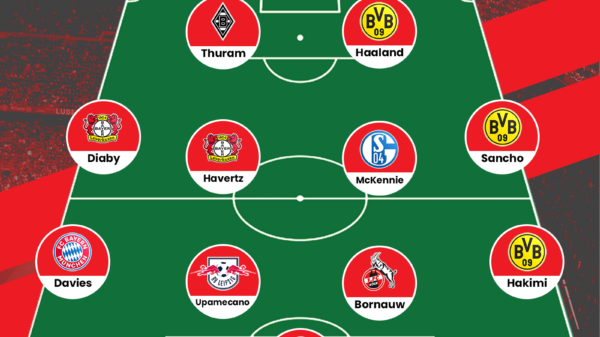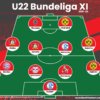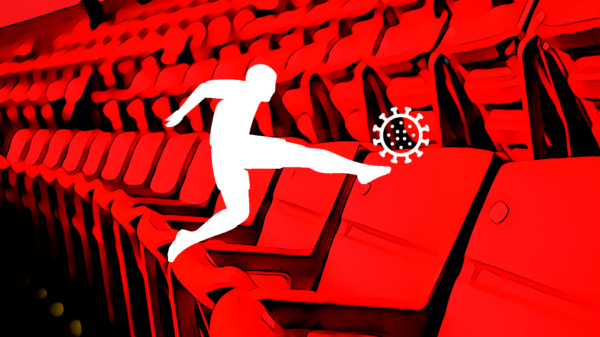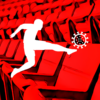James Sutherland writes a detailed tactical analysis of the German Bundesliga match that ended RB Leipzig 1-0 Dortmund.
Dortmund travelled to Leipzig for one of the most fascinating early fixtures in the Bundesliga. It was a game ripe with tactical and narrative hype. On one hand was Dortmund, the clear second best team in Germany but looking to make the jump to challenging Bayern for the title. After a summer of devastating sales and a tough 2-1 win over Mainz to start the season, Thomas Tuchel’s men were looking for a solid performance to put away doubts.
Leipzig, on the other hand, have been rivalled by perhaps only Dortmund and Bayern for media coverage in Germany this summer. The club, created by the company Red Bull, has risen quickly through the German league, winning promotion last season, but it has hardly been a fairy tale story. Instead Leipzig has been the object of much hate and derision from the rest of the league, representing the evils of corporate football for many.
Underlying all of the circus, however, is a strong club. Ralf Ragnick, the great German innovator, serves as technical director, overseeing a team built around young players and aggressive tactics. The matchup of Leipzig, an aggressive, pressing counter attacking side, against Dortmund, now more settled and measured under Tuchel since Jurgen Klopp left, promised to be fantastic.
Line Ups:

Made using Tactical Pad
Leipzig (4-2-2-2): Gulacsi; Halstenberg, Compper, Orban, Klostermann; Kaiser, Ilsanker; Sabitzer, Demine; Poulsen, Werner
Dortmund (4-2-3-1): Burki; Schmelzer, Bartra, Sokratis, Pisczcek; Weigl, Rode; Schurrle, Gotze, Castro; Aubameyang
Ralph Hussenhuttle set Leipzig up in a very Schmidt-esque 4-2-2-2. The midfielders and strikers worked with great coordination when pressing; see below for more. Oliver Burke, Scotland’s most expensive player, started on the bench, although he contributed massively when he came on.
Dortmund, on the other hand, were back to full strength. Julian Weigl, Mario Gotze, Gonzalo Castro and Lukas Pisczcek all made their first league starts of the season. However the sold players, Henrikh Mkhitaryan, Mats Hummels and Ilkay Gundogan, were still sorely missed, as Dortmund’s possession game stalled.
Leipzig’s Defensive Scheme
You could be forgiven for taken a cursory glance at this matchup and deducing how the game would go. Leipzig would be forced deep, sitting in their own half defending while Dortmund dominated the ball and created chances. However, the flow of the match was radically different.
Leipzig’s combination of a high pressure and strong compactness led to a control of the center, leaving Dortmund stale and blunt in possession.
Leipzig pressed high up the field, in a coordinated block. Very reminiscent of Roger Schmidt’s RB Salzburg (a brother team of Leipzig) and Leverkusen, Leipzig’s 6 midfielders and strikers acted as a unit.
During initial buildup Leipzig positioned themselves in a high block but didn’t apply pressure to Dortmund’s centerbacks. Instead of closing down Marc Bartra and Sokratis Leipzig instead cut off all of their immediate passing options, as you can see below.

Bartra or Sokratis would often take several seconds shifting the ball between themselves, trying to open a lane further forward. Then they would push the ball wide, to one of the fullbacks, or longer to a wide midfielder. That’s when Leipzig turned up the pressure.

Now Leipzig’s whole front hexagonal press up. The ball near wide midfielder pressures the fullback, while the central midfielder marks Weigl and shuts down that option. The pass back to the centerbacks is left open intentionally, but you can see both strikers are primed to pressure if the ball goes to Bartra or Sokratis. Meanwhile the ball near fullback has also moved up, cutting off the passing option up the touchline. Pisczcek is forced to pass the ball back to Sokratis.

This time when Sokratis gets the ball Poulsen pressures him. Once again Kaiser marks Weigl, cutting off Sokratis’ forward option. Werner, Leipzig’s other striker, is hanging off Bartra, baiting Sokratis to make that pass.

Once he does Leipzig really turns the pressure up. The situation mirrors the one from seconds ago, on the other side of the field. The striker pressures ball, while the wide midfielder steps up to mark the fullback. Once again Weigl is neutralized in the center, and Bartra is forced to make a dangerous pass to Schmelzer, Dortmund’s left back, running backwards.

Schmelzer plays the ball back to Bartra, and now Leipzig have forced Dortmund into the corner. Bartra is forced to play a long ball to relieve pressure, and because of their strong shape and high line, Leipzig easily win the ball back.
While they did press like that, it wasn’t wholly characteristic of their game. Often times Dortmund were able to retain possession. However Leipzig’s big victory was in making that possession stale and blunt.
This was very much down to their focus on isolating Weigl. The key to Dortmund’s possession game, Weigl has quickly developed into one of the top pivots in the world. Weigl’s fantastic positional intelligence and passing ability allow him to retain possession for Dortmund and open options further up the field. Last year Weigl played a complementary role, as Gundogan and Hummels both contributed greatly to Dortmund’s build up. This year, however, Weigl is really the only great build up player Dortmund has, and much pressure falls on his young shoulders.
Seeing Weigl’s massive important to Dortmund and recognizing that by neutralizing him they could blunt Dortmund’s game, Leipzig focused their defensive scheme on isolating Weigl. As we saw above, their 4-2-2-2 created a hexagon of midfielders and strikers.

This shape was very narrow and compact, forming a prison that Weigl was trapped inside of. The two strikers blocked any passes to Weigl, content to leave the centerbacks on the ball. Indeed, the two highest passing combos in the match were Bartra to Sokratis (39) and Sokratis to Bartra (31). Leipzig was very successful in isolating Weigl and stopping the ball from getting to his feet.
When Weigl did receive a pass Leipzig pressured him immediately. Weigl was forced to either pass the ball back to the centerbacks, where Leipzig would then apply pressure, or to the wings, where Leipzig could trap the ball and win it back for a quick counter.
Weigl wasn’t helped by his partner in the double pivot, Sebastian Rode. Rode’s position was often weak and didn’t balance out Weigl. If Rode had dropped next to Weigl more often, he could have helped create an overload in the center and offer more passing options.
Leipzig’s defensive structure also left Gotze and Aubameyang isolated further up the pitch. Without Weigl, or one of the centerbacks, supplying them, Dortmund’s chief playmakers were left dry. One of Dortmund’s best aspects is their ability to combine in tight areas high up the field, opening defense’s with quick one-twos. But since they couldn’t get past Leipzig’s solid block, Dortmund couldn’t create.
Dortmund Fails to Answer
Weigl’s isolation was as much a personnel issue as a tactical one. Last season, with Gundogan in midfield and Hummels in defense, as well as Mkhi dropping back from attack, Weigl couldn’t have been isolated so easily. Hummels was particularly missed, with Dortmund’s centerbacks turning in a lousy performance.
Afforded time and space on the ball, Bartra and Sokratis showed a complete lack of will to do anything. Instead of trying to penetrate Leipzig’s block by dribbling, and thus freeing Weigl, or by trying to make a long pass to Aubameyang and Gotze on the front line, going over Leipzig, as Hummels would have, the two centerbacks were content to shift the ball between themselves.
Lack of ball progress by #BVB was thought to be because of Weigl’s absence.
It showed again here. Big time.#passmap pic.twitter.com/T8GtyFuWLh— 11tegen11 (@11tegen11) September 10, 2016
Dortmund’s pass map reflects this. The connection between Bartra and Sokratis is massive, while all the other passing connections are either weak or ineffective.
Tuchel made several responses to Leipzig’s tactical setup, trying to break through.
One, used early in the second half, was to have Rode drop into the backline, creating a back three, while the two fullbacks pushed up high. While this did create a 3 v. 2 against Leipzig’s front line, it missed the point. Leipzig was happy to let Dortmund control the ball on their first line, as long as the retained control of the middle. By moving Rode out of the center Tuchel made it easier for Leipzig to do so.
Another option was to allow Leipzig to have the center, and instead play down the wings. With players like Schurrle, Castro and later Dembele wide, as well as Gotze drifting out, Dortmund could theoretically create overloads and break past Leipzig to then cross the ball to Aubameyang. This however played into Leipzig’s pressing scheme, giving them ample chances to trap Dortmund and then break. Dortmund also lacked player ability wide, especially in the fullbacks. Often possession died out there as well.
Dortmund continued to hold the ball and dominate possession for the rest of the match, although Leipzig bravely tried to put together some spells of possession on their own. Leipzig however stuck with their plan, and finally executed it in the 89th minute perfectly. Turning Dortmund over deep in their own half, Oliver Burke dribbled through Dortmund to set Saby Keita up for an easy tap in.
Conclusion
For Leipzig this was a fantastic performance. Not only did they beat Dortmund, but they did so bravely and on their terms. This was no fluke, as Michael Caley’s xG map shows. Leipzig legitimately outplayed Dortmund and fully deserved the win. They are going to be one of the most interesting teams to watch in Europe this season, with a great combination of youth, narrative and tactical interest.
xG map for RB Leipzig – BVB. It’s just two matches, but the early indicators are not great at Dortmund. pic.twitter.com/xR3Kz3WQZt
— Caley Graphics (@Caley_graphics) September 10, 2016
Dortmund could not have imagined a worse result. They weren’t just beaten, they were shut down. Tuchel’s men have started the season very poorly, and all of the questions surrounding them have gotten negative answers. It is clear they are missing Hummels, Gundogan and Mkhi. While they have a team full of young and exciting talent, the early results say that Dortmund may be taking a step back this season.
- Tactical Analysis: Sevilla 2-1 Real Madrid | Sevilla finally end the unbeaten streak - January 21, 2017
- Tactical Analysis: Borussia Dortmund 8-4 Legia Warsaw | Defence thrown out of the windows - November 27, 2016
- Tactical Analysis: RB Leipzig 1-0 Borussia Dortmund | Leipzing outpress Dortmund - September 18, 2016

























































